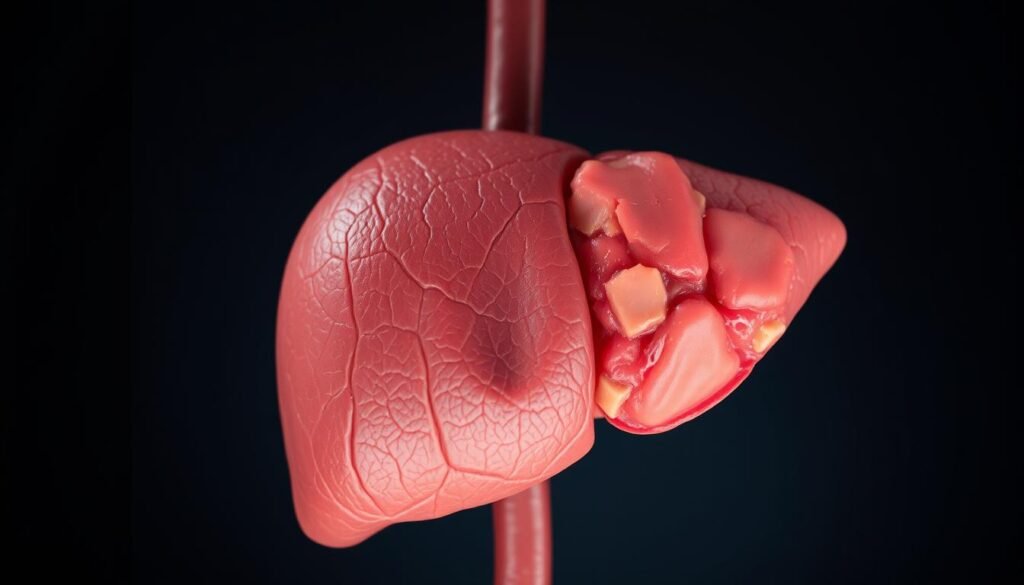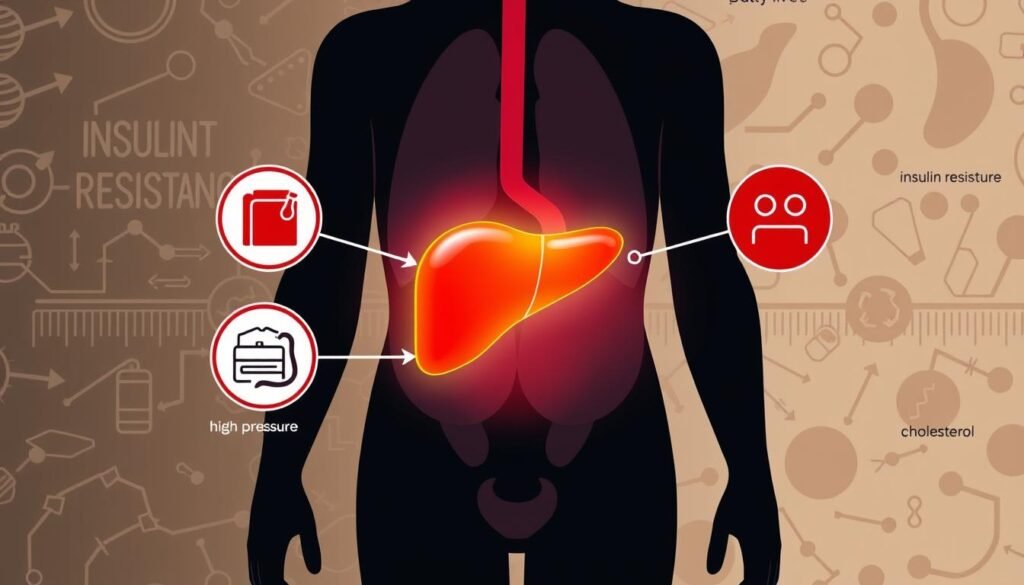Is modern life putting your liver at risk? Metabolic Syndrome and Fatty Liver Disease, especially Non-Alcoholic Fatty Liver Disease, are closely linked. These conditions are affecting more people, with 20-30% in Western countries facing them. This article aims to shed light on how metabolic problems impact liver health. We will look at the main factors, symptoms, and how lifestyle changes can help.
Key Takeaways
- The prevalence of Non-Alcoholic Fatty Liver Disease (NAFLD) ranges from 20-30% in Western countries.
- NAFLD can progress to serious liver conditions, including cirrhosis and liver cancer.
- Insulin resistance is a common factor in both Metabolic Syndrome and NAFLD.
- Significant percentages of individuals with Metabolic Syndrome show multiple risk factors, including obesity and high triglyceride levels.
- The prevalence of NAFLD is particularly high among obese individuals, indicating a strong link between body weight and liver health.
- Understanding these relationships is crucial for effective prevention and treatment strategies.
Understanding Metabolic Syndrome
Metabolic Syndrome is a group of issues that raise the risk for heart disease and diabetes. People with this syndrome often have Insulin Resistance. This is important because 24.1% to 27% of Americans might have it.
Abdominal Obesity is a big sign of Metabolic Syndrome. It means having too much fat around the waist. For men, this is over 94 cm and for women, over 80 cm. High blood pressure is another main part of this syndrome. These three issues together are risky for your health.
Our lifestyle choices can affect Metabolic Syndrome a lot. Bad eating habits and not moving enough can make it worse. To prevent and manage it, it’s good to eat better and exercise more. Doing this can lower your risks and improve your health. More details are available at Metabolic Syndrome details.
Knowing all about Metabolic Syndrome is key. It often happens with other issues like non-alcoholic fatty liver disease. Both share similar risk factors. Being aware helps in managing these health problems better.
People with Metabolic Syndrome can face big health problems. But, noticing it early with regular checks is important. Changing how we live can greatly impact this syndrome. This leads to better health.
Defining Fatty Liver Disease
Fatty Liver Disease is when too much fat builds up in the liver. This often happens in folks who hardly drink alcohol. The condition covers Non-Alcoholic Fatty Liver Disease (NAFLD), including simple steatosis and severe nonalcoholic steatohepatitis (NASH). Simple steatosis means there’s fat in the liver, but no inflammation. NASH, on the other hand, comes with inflammation and maybe liver damage.
NAFLD’s reach varies, but it impacts an estimated 23-25% of people worldwide. Rates soar up to 32% in the Middle East and 30% in South America. Africa, however, reports less at 13%. Location, obesity rates, and local health habits are big factors here.

Metabolic syndrome and Fatty Liver Disease share many risk factors. Being overweight, insulin resistance, and Type 2 Diabetes issues are common in those with NAFLD. About 100 million Americans, or 25% of the population, deal with Non-Alcoholic Fatty Liver Disease (NAFLD). This disease is part of a larger issue called metabolic dysfunction-associated fatty liver disease (MAFLD).
But NAFLD doesn’t just hurt the liver. It also raises the risk of heart diseases and kidney problems. It shows why understanding this disease is crucial for overall health.
Link Between Metabolic Syndrome and Fatty Liver
People are becoming more aware of how Metabolic Syndrome and Fatty Liver Disease are related. Research shows that 53.7% of people with non-alcoholic fatty liver disease (NAFLD) also have Metabolic Syndrome. This shows how these health issues mix together in today’s world.
Insulin resistance is key in linking Metabolic Syndrome and Fatty Liver. This issue, often seen with obesity, causes fat to build up in the liver. It can make the disease worse. Studies say that NAFLD occurs in 16.5% of non-obese people but jumps to 75% in those who are obese.
Having more severe NAFLD raises the chance of Metabolic Syndrome. For mild NAFLD, the odds ratio is about 3.64. For moderate-to-severe NAFLD, it goes up to 9.4. This highlights the tight connection between the two conditions.
The number of people with NAFLD is rising worldwide, now over 32.4%. With Metabolic Syndrome affecting 12.5% to 31.4% of people, tackling both issues is crucial for better health.

Key Risk Factors for Metabolic Syndrome and Fatty Liver
It’s super important to know about Metabolic Syndrome’s risk factors. This helps tackle big health problems today. Obesity, particularly visceral fat, is a huge risk point. Right now, over 1.4 billion adults are overweight, and 500 million are obese. By 2030, we might see around 3.3 billion adults classified as overweight or obese.

Obesity and high blood pressure mix to spike health issues. Stats suggest overweight and obesity cause roughly 3.4 million adult deaths each year. They significantly add to diabetes and problems like heart disease. Having a lot of belly fat is closely linked to insulin resistance, a key problem in Metabolic Syndrome.
Studies show being overweight greatly ups your risk for liver cancer. Obese individuals have nearly twice the risk of liver cancer than those of normal weight. Having diabetes makes it even riskier, raising the chances of getting Non-alcoholic Fatty Liver Disease (NAFLD).
Other factors increasing these health risks are:
- High triglyceride levels
- Glucose intolerance
- Polycystic ovary syndrome
- Sleep apnea
- Sedentary lifestyle
People with metabolic syndrome often get fatty liver. This connects obesity and high blood pressure with more heart disease risk. By understanding these risk factors, we can fight against these health issues. This leads to better health for everyone involved.
Symptoms and Diagnosis of Fatty Liver Disease
Fatty liver disease often goes unnoticed because it doesn’t show signs at first. Many people don’t realize they have it until it’s quite advanced. When symptoms like fatigue, belly pain on the upper right side, and sometimes jaundice appear, it could mean the liver is getting worse. These are warning signs that the liver disease could be moving towards severe conditions like nonalcoholic steatohepatitis (NASH) or cirrhosis.
Diagnosing NAFLD usually starts with blood tests to find high liver enzymes. High levels can indicate liver inflammation or damage. If the tests show something’s wrong, doctors often use ultrasound or CT scans. These scans help see how much fat is in the liver. Keeping the liver healthy is crucial since about 90% of liver cancer cases have cirrhosis involved.
Being overweight, having insulin resistance, and metabolic syndrome are all risk factors for fatty liver disease. Knowing these symptoms and how to diagnose them is key to managing and preventing more liver damage. Catching the early signs can lead to timely help, stopping fatty liver from becoming something worse.
| Symptoms | Description |
|---|---|
| Fatigue | Persistent tiredness even with sufficient rest. |
| Abdominal discomfort | Discomfort or pain in the upper right abdomen. |
| Jaundice | Yellowing of the skin and eyes, indicating advanced liver issues. |
| Elevated liver enzymes | Indicators of liver inflammation found in blood tests. |
| Fat accumulation | Identified through imaging studies. |
Metabolic Syndrome and Fatty Liver: Common Pathophysiological Mechanisms
The link between metabolic syndrome and fatty liver involves key pathophysiological mechanisms of metabolic syndrome. Insulin resistance is crucial, often leading to more fat in the liver and liver damage. This condition, known as non-alcoholic fatty liver disease (NAFLD), ranges from simple fat buildup to severe forms like non-alcoholic steatohepatitis (NASH).
Out of those with NAFLD, about 20% may develop NASH. This can lead to serious liver problems, like fibrosis and cirrhosis.
Having too much visceral fat contributes to long-term inflammation. This inflammation releases harmful proteins from fat tissue, hurting hepatic function. Such local inflammation causes an increase in liver lipid peroxidation. Changes in how fats are handled worsen the liver’s inflammation.
Doctors stress managing these issues to help the liver heal. By focusing on weight control and better insulin sensitivity, patients’ liver health can improve. Checking out detailed insights into these shared mechanisms helps shape treatment plans.
| Pathophysiological Mechanism | Impact on Liver Health |
|---|---|
| Insulin Resistance | Increases fat accumulation in the liver, leading to NAFLD |
| Adipocytokines Release | Induces inflammatory responses, causing liver inflammation |
| Lipid Peroxidation | Damages liver cells, promoting fibrosis and cirrhosis |
| Chronic Inflammation | Contributes to the progression from NAFLD to NASH |
Lifestyle Modifications for Prevention and Management
Lifestyle changes are key in managing Metabolic Syndrome and Fatty Liver. Adopting specific strategies can majorly boost health and might even reverse liver damage. The main suggestions are:
- Weight Loss: Evidence suggests that losing even a small amount of weight can improve liver function significantly. For example, a study showed participants losing an average of 8.7 kg. They followed a low-fat diet, exercised, and had cognitive-behavioral therapy for 48 weeks.
- Increased Physical Activity: At least 210 minutes of exercise a week is beneficial. A study found that NAFLD patients lost 5.6 kg. This was after following a low-fat diet and exercising for 52 weeks.
- Dietary Changes: Eating a diet low in saturated fat and calories helps a lot. Along with moderate exercise, patients lost between 1.9 kg to 2.8 kg in just 12 weeks.
Lifestyle changes do more than just help you lose weight. They also improve how you manage Fatty Liver. For instance, big lifestyle-related weight loss—10% or more—has led to high rates of NASH resolution and less fibrosis, up to 90% and 45%.
It takes work to make these lifestyle changes. Research shows only 10-20% of people lose 10% or more of their body weight over 1-2 years. Help from healthcare professionals can really increase success. They provide ongoing support and motivation, helping people stick with their goals.
For more information on how lifestyle choices affect Fatty Liver Management, you might want to read more about effective interventions here.
Potential Complications of Untreated Fatty Liver
If you don’t treat Fatty Liver Disease, it can lead to grave health problems. This includes various complications of Fatty Liver Disease. Starting with simple fatty liver, or steatosis, it can silently worsen. Many might not see how bad their liver damage is until serious issues appear.
The list of complications includes:
- Non-alcoholic steatohepatitis (NASH): This liver inflammation can lead to fibrosis. That raises the risk of cirrhosis a lot.
- Cirrhosis: A serious liver condition, cirrhosis means bad scarring and weak liver function. It can cause liver failure.
- Liver cancer: Those with worse liver disease have a higher chance of getting hepatocellular carcinoma, a deadly problem.
Non-alcoholic fatty liver disease (NAFLD) affects about 25.2% of people worldwide. Those with it may face end-stage liver disease. It’s key to notice early liver problems.
NAFLD can harm more than your liver. It ups the risk for heart disease, kidney disease, and certain cancers. NAFLD being linked to colorectal lesions makes health outcomes worse.
Knowing the risks and managing them can stop Fatty Liver Disease from getting worse. This includes cirrhosis. Visiting your doctor often and changing your lifestyle are key in preventing bad outcomes.
Conclusion
It’s vital to understand how Metabolic Syndrome and Fatty Liver are connected. Startlingly, 73% of people with metabolic syndrome also have fatty liver. This is much higher than the 38% seen in a control group. Knowing this helps us catch symptoms early and take action for our health.
In the U.S., non-alcoholic fatty liver disease impacts 39% of those with a chronic liver condition. Worldwide, 22% to 29% of adults face this issue. The best way to fight it is through lifestyle changes. Eating well and staying active not only boost liver health but also improve overall well-being. To learn more, check out this resource.
Changing your lifestyle early can greatly lower your health risks. Tackling obesity, insulin resistance, and metabolic syndrome is crucial. This approach improves your liver health and lowers the chance of serious problems later. This discussion shows that taking care of your health now can make a big difference in the future.